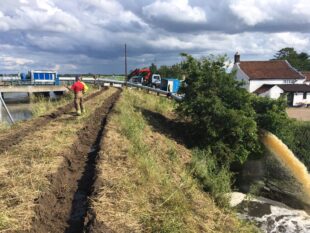 Environment Agency staff monitoring the ultra-high volume pump
Environment Agency staff monitoring the ultra-high volume pump
In Lincolnshire, Environment Agency staff are working 24/7 alongside the emergency services to protect people and property after a river embankment breached at Wainfleet.
In an effort to reduce flood waters, Environment Agency field teams are operating an ultra-high volume pump, capable of pump 5 Olympic-sized swimming pools’ worth of water every hour away from the town. This is now reducing water levels and the repaired breach continues to hold.
The river banks were put under extraordinary pressure because of the extreme amount of rainfall that occurred – more than twice the monthly average in only a couple of days – and subsequently breached.
There has been some reporting that breach has been caused by badger damage or could have been avoided by dredging. This is categorically not the case.
While badgers have been present along the banks in recent years, the part of the embankment that has breached was not affected by badger burrowing or a badger sett. Badgers, as a protected species, were successfully relocated from the flood bank to an artificial sett in August 2018.
Dredging is an important part of our maintenance programme. We consider each location carefully and do it where we know it will make a difference. Environment Agency hydrologists run routine modelling of rivers, including this part of the River Steeping.
Modelling has found that dredging would have made an insignificant difference to this event due to the sheer quantity of rainfall in a short space of time. River levels in this area are also managed through a system of sluices, the biggest of which the Burgh Sluice was refurbished very recently.
The Environment Agency also spends 80k a year on planned maintenance on the River Steeping.
Flooding has a devastating impact on people’s lives and our thoughts are with those affected. There will continue to be an increased flood risk in the Wainfleet area until Saturday, with a risk of heavy thundery showers today (Tuesday), and more prolonged showers tomorrow (Wednesday). Our immediate priority is to repair the bank and pump water away so we can get people back into their homes.
 Ballast bags blocking the breach in a river bank
Ballast bags blocking the breach in a river bank

9 comments
Comment by Cllr. S Wilford posted on
I understood the breach was at Thorpe St Peter not Wainfleet. The public right of way in that area had recently been closed ( it still is along other stretches of the river Steeping bank) and work had been carried out by heavy plant. Can you confirm that the breach did not occur in that area? The soil on the top of the repaired bank appeared to local walkers to still be loose and not compacted down or reinforced.
Comment by A Concerned Wainfleet Resident posted on
Can the EA also clarify:
- whether concerns of an imminent breach in the area the day before it occurred were taken seriously?
- why an emergency was only declared a day after the breach?
- whether the sluice between the Steeping and the Bell Water Drain at Thorpe Culvert was deliberately disabled some time ago, necessitating the high volume pumps to move the water over the bridge instead?
- whether the Gibraltar Point sluices were correctly operating or were full of silt due to lack of maintenance, necessitating the Fire Service pumping water from the river out to sea?
- why the persistent claim that the River Steeping had broken its southern bank (ie had flowed over the bank) was never corrected to say that a section of bank along the Wainfleet Relief Channel - not the river itself - had collapsed on the "dry" side (not through the pressure of the water in the channel) and allowed water to flood the local area?
This last point was a particular concern for residents on the south bank of the Steeping - not the Relief Channel - who were led to believe the river was heading for them but had received no flood alert nor evacuation notice.
Comment by eileenroffe posted on
Hello
You would need to submit this as a freedom of information request by writing into us at:
enquiries@environment-agency.gov.uk
Regards Amy
Comment by eileenroffe posted on
Hello
To save you emailing in ill forward your request onto the correct team now and we will let you know when they respond.
Regards Amy
Comment by Wendy A Large posted on
Doo any of the residents need to replace clothes lost by the flooding and where should replacements be sent
Comment by Wendy A Large posted on
Do any of the residents need to replace clothes lost by the flooding and where should replacements be sent
Comment by john stephenson posted on
There is so much that has been left out by the E.A. in their attempt to deflect blame.It is not mentioned the doors from the Burgh Sluice to the Bellwater were permanently disabled 20 years ago because the new pump at Thorpe Culvert was thought to be adequate.What they didn't say was the new pumps were electric and dependent on an electric supply.Secondly when River Steeping was at full capacity there was nowhere to pump the water from Burgh Sluice.
Comment by j merry posted on
Perhaps someone can answer my questions
-Where can I get channel data on the river Steeping and the relief channel, such as the discharge, embankment hights and velocity?
-Would the embankments been breached if they did not burst?
-Why had nothing been done about the weak embankment after reports that is was unsafe?
-Is the relief channel being used as the main river?
-How will the current defences cope with climate change over the next 20 years?
Comment by eileenroffe posted on
Hello
You would need to submit this as a freedom of information request by emailing our team at:
enquiries@environment-agency.gov.uk
Our team will then be able to research your enquiry and they will respond to you within 10- 20 working days.
Many thanks Amy